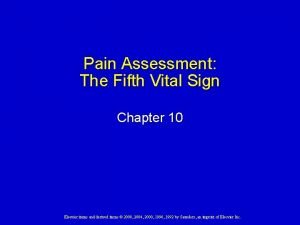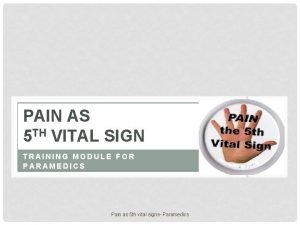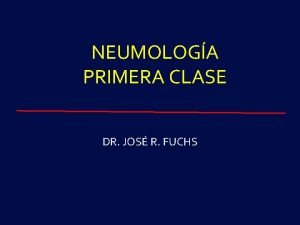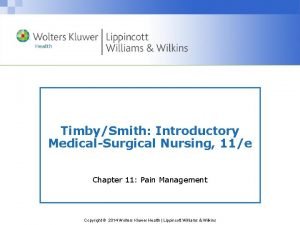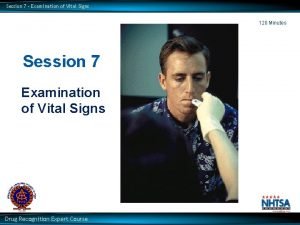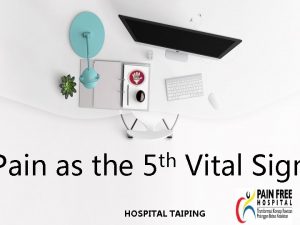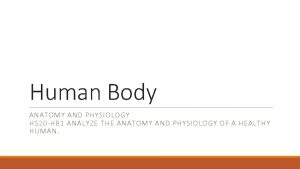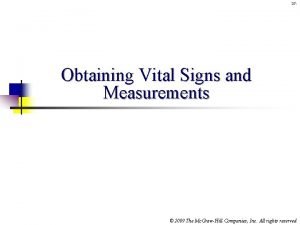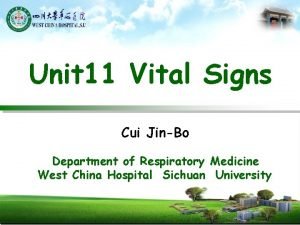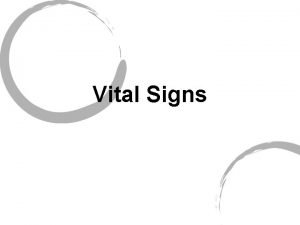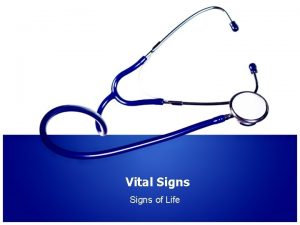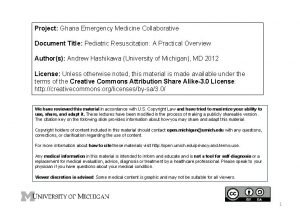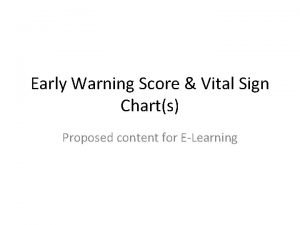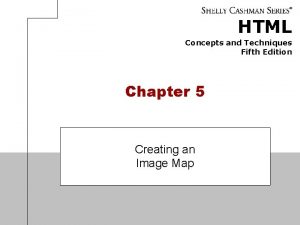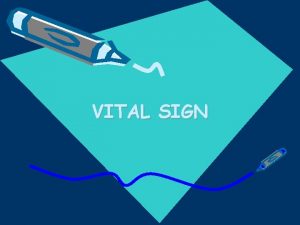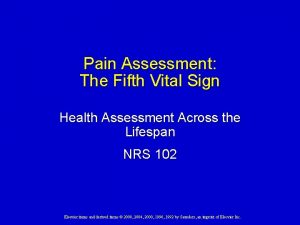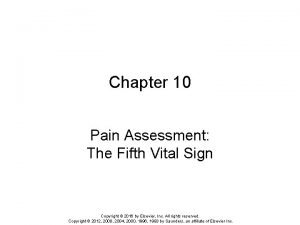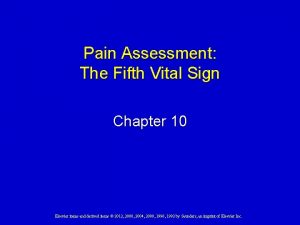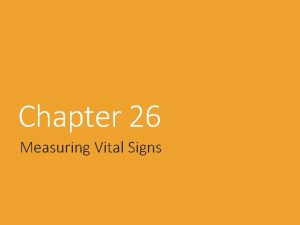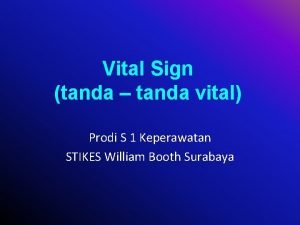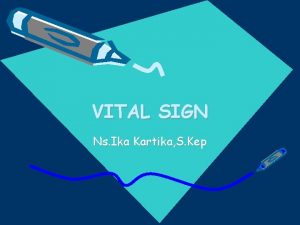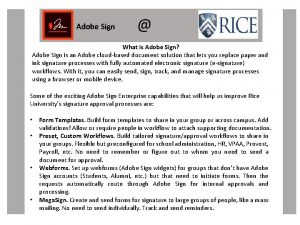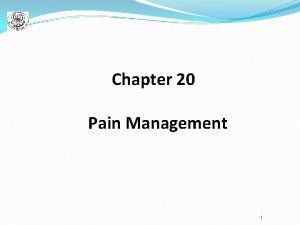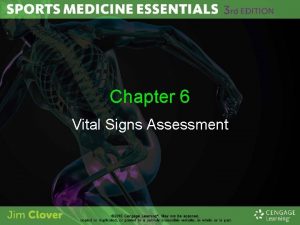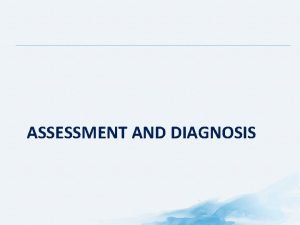Pain Assessment The Fifth Vital Sign Chapter 10























- Slides: 23

Pain Assessment: The Fifth Vital Sign Chapter 10 Elsevier items and derived items © 2008, 2004, 2000, 1996, 1992 by Saunders, an imprint of Elsevier Inc.

Chapter 10: Pain Assessment: The Fifth Vital Sign Structure and Function Neuroanatomic pathway Nociception Neuropathic pain Sources of pain Types of pain Elsevier items and derived items © 2008, 2004, 2000, 1996, 1992 by Saunders, an imprint of Elsevier Inc. Slide 10 -2

Chapter 10: Pain Assessment: The Fifth Vital Sign Neuroanatomic Pathway Nociceptors Interneurons Anterolateral spinothalamic tract Elsevier items and derived items © 2008, 2004, 2000, 1996, 1992 by Saunders, an imprint of Elsevier Inc. Slide 10 -3

Chapter 10: Pain Assessment: The Fifth Vital Sign Neuroanatomic Pathway (cont. ) Elsevier items and derived items © 2008, 2004, 2000, 1996, 1992 by Saunders, an imprint of Elsevier Inc. Slide 10 -4

Chapter 10: Pain Assessment: The Fifth Vital Sign Nociception Transduction Transmission Perception Modulation Elsevier items and derived items © 2008, 2004, 2000, 1996, 1992 by Saunders, an imprint of Elsevier Inc. Slide 10 -5

Chapter 10: Pain Assessment: The Fifth Vital Sign Nociception (cont. ) Elsevier items and derived items © 2008, 2004, 2000, 1996, 1992 by Saunders, an imprint of Elsevier Inc. Slide 10 -6

Chapter 10: Pain Assessment: The Fifth Vital Sign Neuropathic Pain Abnormal processing of pain message Most difficult type of pain to assess and treat Neurochemical level Elsevier items and derived items © 2008, 2004, 2000, 1996, 1992 by Saunders, an imprint of Elsevier Inc. Slide 10 -7

Chapter 10: Pain Assessment: The Fifth Vital Sign Sources of Pain Visceral pain Deep somatic pain Cutaneous pain Referred pain Elsevier items and derived items © 2008, 2004, 2000, 1996, 1992 by Saunders, an imprint of Elsevier Inc. Slide 10 -8

Chapter 10: Pain Assessment: The Fifth Vital Sign Common Sites for Referred Pain © Pat Thomas, 2006. Elsevier items and derived items © 2008, 2004, 2000, 1996, 1992 by Saunders, an imprint of Elsevier Inc. Slide 10 -9

Chapter 10: Pain Assessment: The Fifth Vital Sign Types of Pain Acute pain Ø Short term Ø Self-limiting Ø Follows a predictable trajectory Ø Dissipates after injury heals Chronic pain Ø Continues for 6 months or longer Ø Types are malignant (cancer related) and nonmalignant Ø Does not stop when injury heals Elsevier items and derived items © 2008, 2004, 2000, 1996, 1992 by Saunders, an imprint of Elsevier Inc. Slide 10 -10

Chapter 10: Pain Assessment: The Fifth Vital Sign Subjective Data—Health History Pain assessment questions Pain assessment tools Elsevier items and derived items © 2008, 2004, 2000, 1996, 1992 by Saunders, an imprint of Elsevier Inc. Slide 10 -11

Chapter 10: Pain Assessment: The Fifth Vital Sign Pain Assessment Questions to ask: Ø How does pain limit your function/activities? Ø How do you behave when you are in pain? How would others know you are in pain? How much pain do you have now? Ø What does pain mean to you? What makes the pain better or worse? Ø Why do you think you are having pain? Ø Where is your pain? Ø When did your pain start? Ø What does your pain feel like? Ø Ø Elsevier items and derived items © 2008, 2004, 2000, 1996, 1992 by Saunders, an imprint of Elsevier Inc. Slide 10 -12

Chapter 10: Pain Assessment: The Fifth Vital Sign Pain Assessment Tools Initial pain assessment Brief pain inventory Pain rating scales Ø Numeric rating scales Ø Descriptor scale Elsevier items and derived items © 2008, 2004, 2000, 1996, 1992 by Saunders, an imprint of Elsevier Inc. Slide 10 -13

Chapter 10: Pain Assessment: The Fifth Vital Sign Initial Pain Assessment From Mc. Caffery M, Pasero C: Pain: Clinical manual, ed 2, St. Louis, 1999, Mosby. Elsevier items and derived items © 2008, 2004, 2000, 1996, 1992 by Saunders, an imprint of Elsevier Inc. Slide 10 -14

Chapter 10: Pain Assessment: The Fifth Vital Sign Brief Pain Inventory From Mc. Caffery M, Pasero C: Pain: Clinical manual, ed 2, St. Louis, 1999, Mosby. Elsevier items and derived items © 2008, 2004, 2000, 1996, 1992 by Saunders, an imprint of Elsevier Inc. Slide 10 -15

Chapter 10: Pain Assessment: The Fifth Vital Sign Objective Data—Physical Exam Joints—note Ø Size/contour/circumference Ø AROM/PROM Muscles/skin—inspect Ø Color/swelling Ø Masses/deformity Ø Sensation changes Elsevier items and derived items © 2008, 2004, 2000, 1996, 1992 by Saunders, an imprint of Elsevier Inc. Slide 10 -16

Chapter 10: Pain Assessment: The Fifth Vital Sign Objective Data—Physical Exam (cont. ) Abdomen—inspect and palpate Ø Contour/symmetry Ø Guarding/organ size Pain behavior—inspect Ø Nonverbal cues Ø Acute pain behavior Ø Chronic pain behavior Elsevier items and derived items © 2008, 2004, 2000, 1996, 1992 by Saunders, an imprint of Elsevier Inc. Slide 10 -17

Chapter 10: Pain Assessment: The Fifth Vital Sign Acute Pain Behaviors Guarding Grimacing Vocalizations such as moaning Agitation, restlessness Stillness Diaphoresis Change in vital signs Elsevier items and derived items © 2008, 2004, 2000, 1996, 1992 by Saunders, an imprint of Elsevier Inc. Slide 10 -18

Chapter 10: Pain Assessment: The Fifth Vital Sign Chronic Pain Behaviors Bracing Rubbing Diminished activity Sighing Change in appetite Being with other people Movement Exercise Prayer Sleeping Elsevier items and derived items © 2008, 2004, 2000, 1996, 1992 by Saunders, an imprint of Elsevier Inc. Slide 10 -19

Chapter 10: Pain Assessment: The Fifth Vital Sign Sample Charting Elsevier items and derived items © 2008, 2004, 2000, 1996, 1992 by Saunders, an imprint of Elsevier Inc. Slide 10 -20

Chapter 10: Pain Assessment: The Fifth Vital Sign Abnormal Findings Reflexive sympathetic dystrophy Ø Follows trauma to the nerve Ø Most commonly appears in 40 - to 60 -year-old men and women Elsevier items and derived items © 2008, 2004, 2000, 1996, 1992 by Saunders, an imprint of Elsevier Inc. Slide 10 -21

Chapter 10: Pain Assessment: The Fifth Vital Sign Which type of pain would cholecystitis (gallbladder disease) cause? A. Somatic B. Visceral C. Cutaneous D. Chronic Elsevier items and derived items © 2008, 2004, 2000, 1996, 1992 by Saunders, an imprint of Elsevier Inc. Slide 10 -22

Chapter 10: Pain Assessment: The Fifth Vital Sign What anticipated finding regarding patients with chronic pain should guide a nurse’s care planning? A. B. C. D. Patients with chronic pain have trouble sleeping. Patients with chronic pain show elevated blood pressures. Patients with chronic pain need less medication. Patients with chronic pain may show few or no outward signs of pain. Elsevier items and derived items © 2008, 2004, 2000, 1996, 1992 by Saunders, an imprint of Elsevier Inc. Slide 10 -23
 Pain as the fifth vital sign
Pain as the fifth vital sign Analgesic ladder kkm
Analgesic ladder kkm Sign shapes meaning
Sign shapes meaning Capacidad vital y capacidad vital forzada
Capacidad vital y capacidad vital forzada Mad pain and martian pain
Mad pain and martian pain Can early pregnancy feel like period cramps
Can early pregnancy feel like period cramps Symptoms before period
Symptoms before period Jarvis chapter 11 pain assessment
Jarvis chapter 11 pain assessment Pulse sites
Pulse sites What are the 8 vital signs?
What are the 8 vital signs? Vital signs normal range
Vital signs normal range Vital sign form
Vital sign form Vital sign form
Vital sign form Hunger vital sign
Hunger vital sign Vital signs normal range
Vital signs normal range 9 lokasi denyut nadi
9 lokasi denyut nadi Orthostatic vital signs
Orthostatic vital signs Orthostatic vital sign
Orthostatic vital sign Vital signs
Vital signs Normal vitals
Normal vitals Normal vitals in pediatrics
Normal vitals in pediatrics Vital sign chart
Vital sign chart Senge fifth discipline summary
Senge fifth discipline summary Fifth chapter menu
Fifth chapter menu
